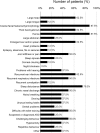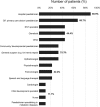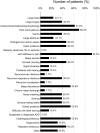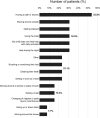Pathway to diagnosis and burden of illness in mucopolysaccharidosis type VII - a European caregiver survey
- PMID: 31727109
- PMCID: PMC6854616
- DOI: 10.1186/s13023-019-1233-z
Pathway to diagnosis and burden of illness in mucopolysaccharidosis type VII - a European caregiver survey
Abstract
Background: Mucopolysaccharidosis type VII (Sly disease, MPS VII), is an ultra-rare, multi-symptom disease with variable clinical presentations which can present challenges with diagnosis, management and care. We believe this survey is the first to explore the patient experience through direct questioning of the caregivers of 13 individuals with MPS VII.
Methods: This European survey, using a specifically designed questionnaire, was conducted in order to describe the pathway to diagnosis and the burden of illness of MPS VII. Information on early symptoms, clinicians seen, and current symptoms was collected. Questions on the caregivers' ability to work and the use and availability of health, social and educational support were included.
Results: Caregivers of 13 patients from Germany, Spain, The Netherlands and Turkey responded to the survey. Five patients with non-immune hydrops fetalis (NIHF) were diagnosed with MPS VII at a mean age of 1.9 years (median 0.3 years, range 0.2 to 6 years). Those without NIHF (n = 7) were diagnosed at a mean age of 6.1 years (median 6.0 years, range 1.9 to 14 years). The symptoms most likely to raise a suspicion of MPS VII, excluding NIHF, did not appear until a median age of at least three years. Over one half of patients required assistance with daily living and mobility. Reduction of the working hours of caregivers was often necessary (46.2% reduced hours, 30.8% stopped working). Patients attended frequent medical appointments (12.7/year), over 80% had surgery and 30% had been hospitalised for respiratory issues. While support for learning and behavioural needs was generally available, support for mobility was not available to 50% of patients. Half of the respondents (6/12) said they were not offered genetic counselling.
Conclusions: For children that do not present with NIHF, diagnosis can take several years as early symptoms can be non-specific and mistaken for other conditions. Increased awareness of the early signs of disease and more information for parents/caregivers at diagnosis are needed. MPS VII poses significant burden to patients, caregivers, healthcare, social and educational services. Access to information and support varies across Europe and the availability of genetic counselling is limited in some countries.
Keywords: Burden of illness; Caregiver burden; Diagnosis; Diagnostic delay; Diagnostic odyssey; Lysosomal storage disorder; MPS VII; Mucopolysaccharidosis type VII; Sly disease.
Conflict of interest statement
AM declares that she has no competing interests. TF declares that she has no competing interests. JC declares that he has no competing interests. NY declares that she has no competing interests. EO participated in an advisory board for Ultragenyx.
Figures






Similar articles
-
Clinical course of sly syndrome (mucopolysaccharidosis type VII).J Med Genet. 2016 Jun;53(6):403-18. doi: 10.1136/jmedgenet-2015-103322. Epub 2016 Feb 23. J Med Genet. 2016. PMID: 26908836 Free PMC article.
-
A new case report of severe mucopolysaccharidosis type VII: diagnosis, treatment with haematopoietic cell transplantation and prenatal diagnosis in a second pregnancy.Ital J Pediatr. 2018 Nov 16;44(Suppl 2):128. doi: 10.1186/s13052-018-0566-x. Ital J Pediatr. 2018. PMID: 30442200 Free PMC article.
-
Social/economic costs and health-related quality of life of mucopolysaccharidosis patients and their caregivers in Europe.Eur J Health Econ. 2016 Apr;17 Suppl 1:89-98. doi: 10.1007/s10198-016-0787-0. Epub 2016 Apr 9. Eur J Health Econ. 2016. PMID: 27062257
-
Mucopolysaccharidosis type VII (Sly syndrome) - What do we know?Mol Genet Metab. 2024 Mar;141(3):108145. doi: 10.1016/j.ymgme.2024.108145. Epub 2024 Jan 17. Mol Genet Metab. 2024. PMID: 38301529 Review.
-
Mucopolysaccharidosis VII in Brazil: natural history and clinical findings.Orphanet J Rare Dis. 2021 May 22;16(1):238. doi: 10.1186/s13023-021-01870-w. Orphanet J Rare Dis. 2021. PMID: 34022924 Free PMC article. Review.
Cited by
-
Carer burden in rare inherited diseases: a literature review and conceptual model.Orphanet J Rare Dis. 2022 Dec 9;17(1):428. doi: 10.1186/s13023-022-02561-w. Orphanet J Rare Dis. 2022. PMID: 36494728 Free PMC article. Review.
-
A systematic review and integrative sequential explanatory narrative synthesis: The psychosocial impact of parenting a child with a lysosomal storage disorder.J Inherit Metab Dis. 2022 May;45(3):406-416. doi: 10.1002/jimd.12482. Epub 2022 Feb 24. J Inherit Metab Dis. 2022. PMID: 35124835 Free PMC article. Review.
-
A de novo homozygous missense mutation of the GUSB gene leads to mucopolysaccharidosis type VII identification in a family with twice adverse pregnancy outcomes due to non-immune hydrops fetalis.Mol Genet Metab Rep. 2023 Dec 6;38:101033. doi: 10.1016/j.ymgmr.2023.101033. eCollection 2024 Mar. Mol Genet Metab Rep. 2023. PMID: 38149215 Free PMC article.
-
Misdiagnosis in mucopolysaccharidoses.J Appl Genet. 2022 Sep;63(3):475-495. doi: 10.1007/s13353-022-00703-1. Epub 2022 May 13. J Appl Genet. 2022. PMID: 35562626 Review.
-
Prenatal mucopolysaccharidosis VII: A novel pathogenic variant identified in GUSB gene.Clin Case Rep. 2020 Dec 11;9(2):790-795. doi: 10.1002/ccr3.3644. eCollection 2021 Feb. Clin Case Rep. 2020. PMID: 33598246 Free PMC article.
References
-
- MPS Society. Guide to Understanding Mucopolysaccharidosis VII (MPS VII) Sly. Amersham: MPS Society; 2013.
-
- Orphanet: Mucopolysaccharidosis type 7. https://www.orpha.net/consor/cgi-bin/OC_Exp.php? Expert=584. Accessed 20 March 2019.
Publication types
MeSH terms
LinkOut - more resources
Full Text Sources
Medical

